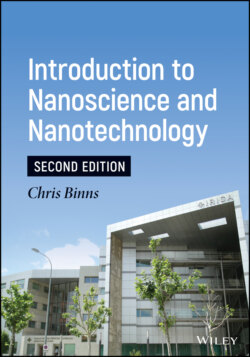Читать книгу Introduction to Nanoscience and Nanotechnology - Chris Binns - Страница 18
1.2 The Magnetic Behavior of Nanoparticles
ОглавлениеIt is widely known that Fe is a magnetic material, but in fact, a piece of pure (or “soft”) Fe is not magnetized. This is easy to prove by taking a piece of soft Fe and seeing that it does not attract a ball bearing (Figure 1.4a). In contrast, a permanent magnet, which is an alloy, such as neodymium–iron–boron (Nd–Fe–B) that is permanently magnetized strongly attracts the ball bearing (Figure 1.4b). A simple and illustrative experiment is to sandwich the ball bearing between the permanent magnet and piece of soft Fe, and then pull the magnet and the pure Fe apart (Figure 1.4c). Oddly, while the ball bearing shows no attraction to the soft Fe on its own, in the presence of the magnet it stays glued firmly to the piece of soft Fe as it is pulled away, showing that the soft Fe is magnetized to a greater degree than the actual magnet. Beyond a certain distance from the magnet the soft Fe reverts to its demagnetized state and the ball bearing comes loose (Figure 1.4d).
The source of magnetism in materials is their constituent atoms, which consist of tiny permanent dipolar magnets whose strength is given by the magnetic moment1 of the atom (see Advanced Reading Box 1.1). In a material such as Fe, there is a strong interaction (the exchange interaction) between the atoms that line up the atomic magnets to produce a macroscopic magnetization. Note that the exchange interaction is a quantum mechanical effect and is not the normal interaction that you would see between two bar magnets, for example. For one thing, the interaction between bar magnets aligns them in opposite directions and for another, the exchange interaction is thousands of times stronger than the direct magnetic interaction.
Figure 1.4 Simple experiment to demonstrate magnetic domains. (a) Soft Fe does not attract the ball bearing. (b) A conventional magnet does; however, (c) when the soft Fe is magnetized by being in the presence of the magnet, it becomes more magnetic than the magnet and the ball bearing stays with the soft Fe in preference to the magnet. (d) The situation persists until the magnet is far enough away that the soft Fe reverts to its domain structure and externally generates no magnetic field.
